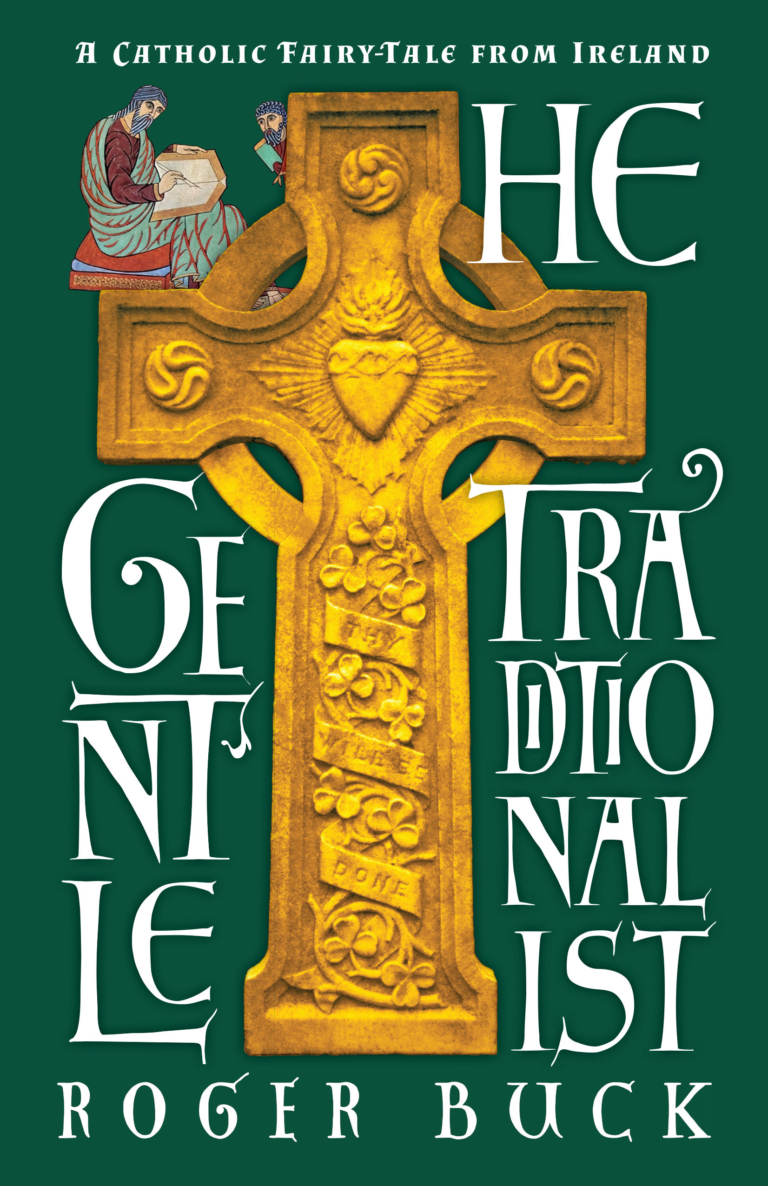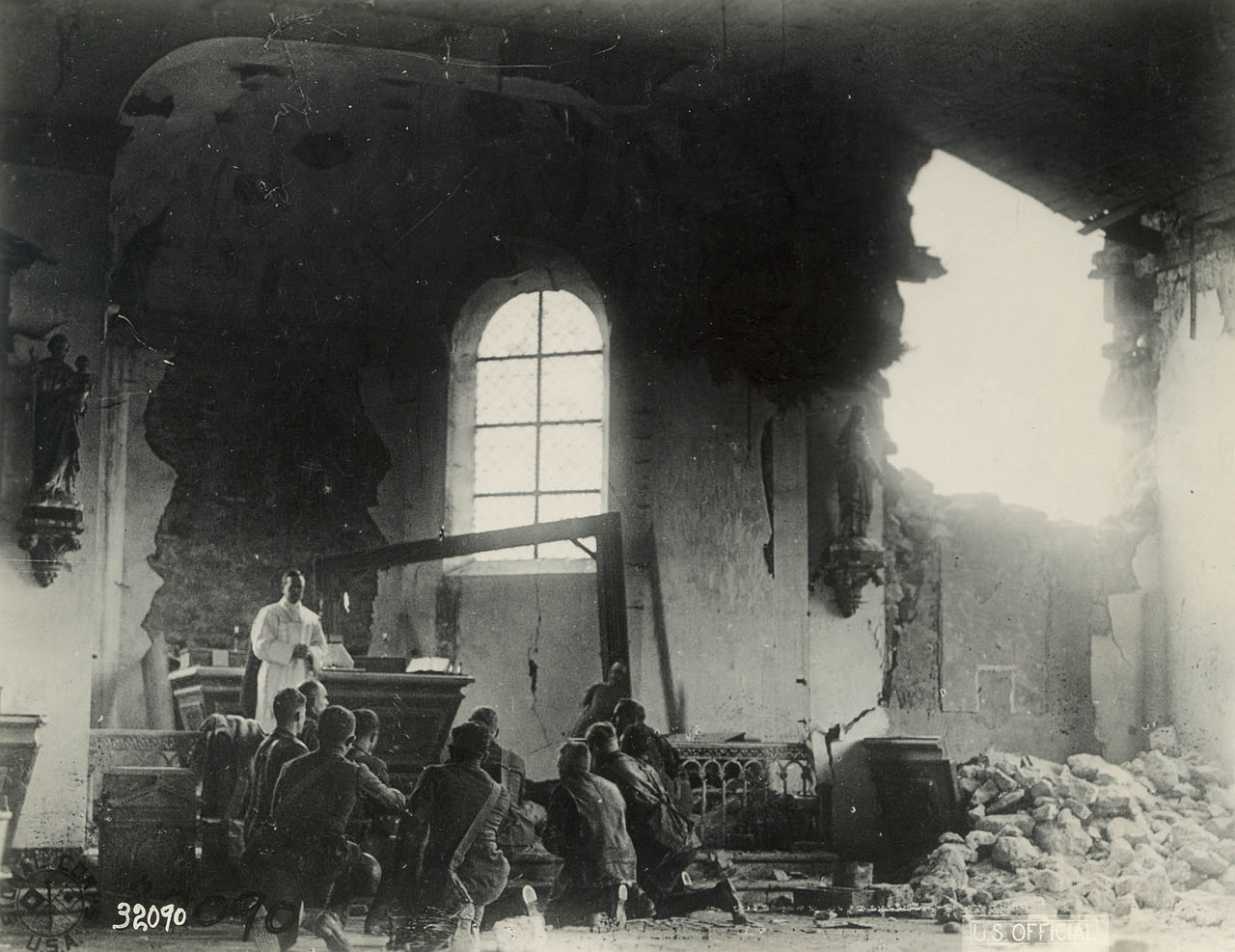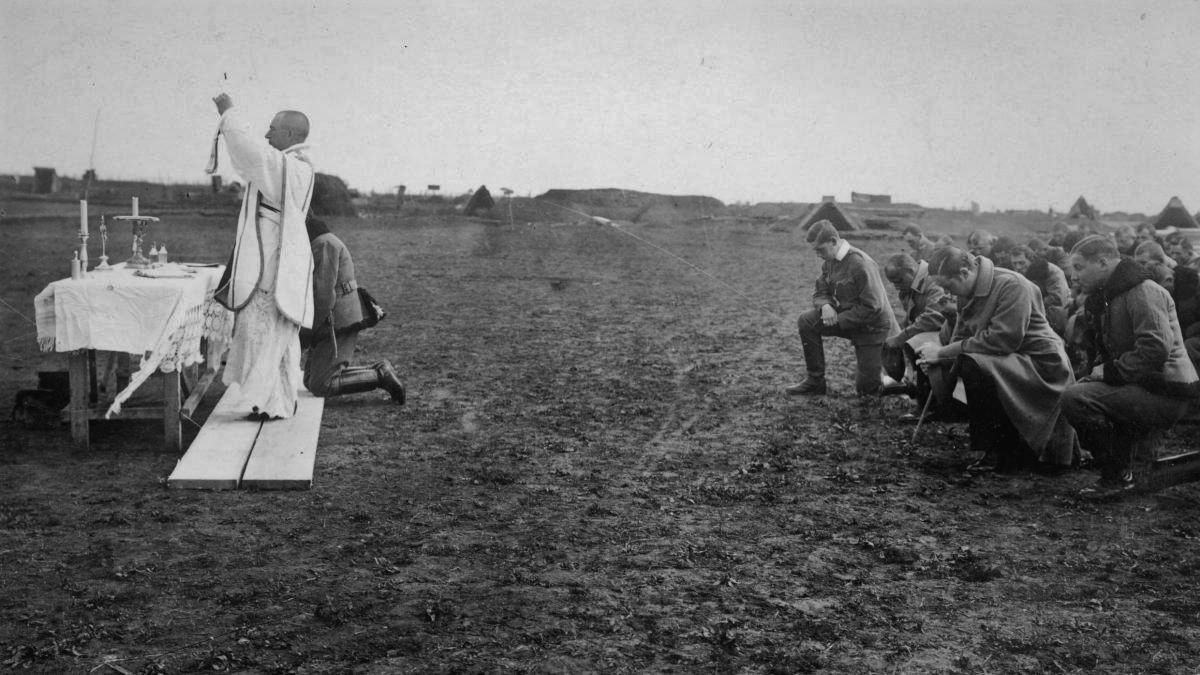From The Remnant
By Dr Peter Kwasniewski
The English American author Roger Buck, who with his wife Kim now lives in the land of St. Patrick, has become an eloquent prophet of Ireland’s unique blessings and accelerating decadence, a lens through which he views the story of the Church in the West. In three gripping books—two whimsical novels set in Ireland and featuring a mysterious character known as Gilbert Tracey or the Gentle Traditionalist, and a moving philosophical autobiography—Buck describes a circuitous path of conversion from ardent champion of New Age religion to “the Mystery” that traditional Catholicism has harbored, defended, and offered to a shipwrecked mankind for 2,000 years.
In this article I would like to examine passages in his books that touch on Buck’s growing awareness of the centrality of the traditional Latin Mass to Catholicism as such, and to its “fortunes” in the modern era.
Like so many others, Buck was drawn to the Catholic Church partly through the example of John Paul II and the intellectual contribution of Joseph Ratzinger. Yet he saw with increasing clarity, even before the pontificate of Francis, that something was desperately amiss: in spite of the confident message of the Polish pope, the Church seemed to be paralyzed or handicapped; she was limping, not running. In spite of the learned musings of Benedict, the Church was slowly losing her identity and (in a sense) her mind, as if succumbing to an ecclesiastical Alzheimer’s disease. There was a fracture or wound at the center. What was it?
 The Winding Path to Conversion
The Winding Path to Conversion
In his first book, The Gentle Traditionalist (Angelico Press, 2015), Buck, or at least his narrator, the somewhat vacillating Geoffrey Luxworthy, has not yet “arrived”—and perhaps neither has Geoffrey’s lady love, Anna, who tried her vocation in a strict traditionalist order but after leaving still attends the Novus Ordo:
I found Anna’s attitudes towards the Church completely contradictory. For one thing, she’d gone all the way to a Latin Mass convent in Marseilles, because she couldn’t bear the new liturgy. But now in Monaghan she went to an English Mass—every single day.
“There’s no Latin Mass for miles around,” she “explained.”
“Then why go to an English Mass, if you don’t like it?”
“The Mass is the Mass is the Mass,” she said, “but you won’t understand that, unless you know what the Mass is. Christ is still present there—whether you like the liturgy or not.”
“You mean as something to eat?” I scoffed.
“I told you, you wouldn’t understand.”
I didn’t. Nor could I understand why she wanted to go to a Mass in a dead language. From what I understood, the Catholic Church had changed the Mass when it liberalised itself in the 1960s. This liberalisation looked like a good thing to me. But Anna thought the changes in the Church were slowly killing it. Since the ’60s, she told me, there’d been massive declines in vocations—as well as Catholic baptisms, marriages, etc. People were abandoning the Church in droves. She was particularly worried that very few people bothered with Confession anymore. The new liturgy, according to her, was a major part of the problem. Apparently, a “mystic life-force” was being drained from the Church. Anna might be a Catholic now, but she still sounded like a nutty New Ager to me. (25–26)
Well into the story, after “Gilbert Tracey” has shown up, engaging all and sundry in animated conversation, we hear his diagnosis:
“Unfortunately, today’s Church doesn’t understand the power of its own Sacraments. Or sacramentals—like this Holy Water or the Rosary. This is the tragedy of the post-Vatican II Church. Large parts of it have surrendered to faith in rationalism, rather than keeping faith in tradition.
“The Church must recover her tradition. Only tradition understands the immense, healing power of the Sacraments. That power can save civilisation. If people returned to Confession, if people took the Mass seriously again, there’s no telling what would happen.
“But how can ordinary people take those things seriously, when the priests and bishops don’t either?”
Once again, he stared at the floor in terrible sadness. Then he added: “That’s why Anna goes to the Latin Mass. You must understand—for her it’s very, very serious. The Church has no hope of recovery without true, reverent liturgy. Benedict XVI said something once, when he was still Cardinal Ratzinger. What was it now...?” His voice trailed off.
“Ah, yes, I remember,” GT said, suddenly speaking with great force: “‘The ecclesial crisis in which we find ourselves today depends in great part upon the collapse of the liturgy.’ Yes, Benedict XVI realised the true scope of the disaster. In her own way, so does Anna.” (161)

The Convert’s Awakening to Crisis
Sometime later, after Geoffrey has converted to Catholicism and married Anna, he begins to see the world through her eyes—and her own vision sharpens as well. In the sequel, The Gentle Traditionalist Returns (Angelico Press, 2019; intended as a stand-alone story), Geoffrey puts the matter this way, showing a definite progression of thought:
We went [regularly] to a Latin Mass, offered by a French institute dedicated to Christ the King. Unlike my wife, I had hardly experienced the new English Mass initiated after Vatican II. I went straight from my old secular life to Tridentine liturgy. Anna called that “a rare privilege” for a convert in this day and age. And day after day, the Latin Mass worked on me, shaping my soul.
Now, in Anna’s view, the loss of that Latin Mass carried tragic consequences for the Church. Yes, she admitted, certain priests could and did celebrate the new liturgy with dignity. But they were a minority. Across the world, millions were subjected to a morass of muzak and mediocrity that obscured the Miracle at the Altar. In Anna’s view this was slowly, insidiously destroying the Church.
Groan. Surely, it wasn’t that big a deal was it? Surely, she was over-reacting again! Didn’t the Church teach that the Body and Blood of Christ were truly present in the new Mass? Wasn’t it a contradiction, then, to consider the old Mass objectively superior to the new?
But Anna responded with an unusual analogy. She likened the new vernacular liturgy to a sieve. This strange image reconciled two apparently conflicting claims. For, on the one hand, the Church maintained that Christ was equally present in both Masses. Anna accepted that. But, on the other hand, the New Mass clearly lacked something. That was plain to her. Heck, it was even plain to me! People behaved differently at the new Mass. Their attention wandered all over the place. That was perfectly clear from the few times I went to it. Even the priests sometimes appeared absent-minded and sloppy, at least by comparison to the palpable reverence at the old Mass.
Anna’s analogy of the sieve resolved this tension between the two Masses. Yes, Jesus Christ became fully present in every valid Mass, new or old. But the traditional Mass provided something further, a crucial addition: a container that aided and HELD His Presence. That container was created through the sacred language of ecclesiastical Latin and the rubrics, prayers and gestures omitted in the new Mass. The fact that the Tridentine liturgy instilled reverence, naturally directing people’s attention to the Mystery, amplified its effect. That old container was missing in the new Mass, replaced by something else—something that did not hold or facilitate the proper attention, piety and receptivity to the Mystery at the Altar. Something that leaked like a sieve. All the omissions acted as HOLES. That was why the new Mass often, if not always, degenerated into a slovenly affair. (8–9)
(Buck has spoken about the sieve analogy in a video talk as well.)
Later in the book, Geoffrey’s wife, Anna, sees a vision in the blood-red stone in the ring worn by the Gentle Traditionalist:
Heaven and hell, hope and horror teetered back and forth in her as the ring divulged more. Another immeasurable tragedy: Anna realised the new Mass omitted the invocation of St Michael. And all God’s elect. Just like it omitted so much else.
Now, Anna saw that her analogy of the New Mass as a sieve was apt. Yes, Christ’s Body and Blood remained present in this new Mass, celebrated a hundred thousand times a day. The beating Planetary Heart, the Mass, was still there. But the old Mass carried more graces. Secondary graces, yes, but hardly insignificant ones—particularly when multiplied a hundred thousand times a day!
Now, grace was squandered. Christ’s Church was weakened. Angels wept.
Fear, once more, clutched her heart. Everything depended on the Mass being properly received and integrated. She saw Archbishop Bugnini, architect of the new Mass, before the pope mysteriously stripped him of his duties, banishing him to ecclesiastical “Siberia.” Bugnini was gone, but Bugninism lived on.
But Anna saw that Bugninism, too, would pass. Even now, the Liturgy was being slowly, steadily restored. Amidst the “Spirit of Vatican II”—that strange, self-assured euphoria—the old Mass had been almost abolished. Through the courage and perseverance of a few good priests and bishops, the Latin Mass held on. And there was something else: Anna saw Angels standing behind these men, inspiring their efforts. And when Pope Benedict XVI liberated the Latin liturgy, the Angels rejoiced. Now, thousands of young priests were turning to the old Mass, often to their elders’ chagrin. (151)
The language in the passage that follows is quite intense:
[N]ow Anna saw the darkness Angels see—their separated brethren: fallen Angels. Terrifying, demonic forces were pitted against humanity. Stalinism, Hitlerism, Bugninism, the new gender ideology destroying children: all were fruits of collaboration. Collaboration between the tempters and the tempted: fallen Angels and fallen humanity. (151–52)
Some might regard such language as “over the top,” but I think it is exactly right: there is certainly no other way to explain the devastation that was wrought on the Catholic liturgy after World War II, culminating in an unimaginable reconstruction of it in the late 1960s that obliterated almost any trace of the worship offered for millennia by Latin-rite Catholics. If Stalin caused such destruction to Russia and its surrounding countries; if Hitler did the same to Germany and much of Europe; and if both together nearly shattered the Western world, the liturgical revolution did the same analogously in the Catholic Church: while it did not succeed in ridding the Earth of the Holy Sacrifice of the Mass, it gravely compromised its integrity, sacrality, and efficacy. It would be no exaggeration to call this reform an apocalyptic caesura or rupture, both an effect and a harbinger of catastrophic infidelity.
Satan’s strategy against the Catholic Church has become progressively more refined. He still readily employs the coarse sins of lust, gluttony, and avarice, which will always have their “takers,” but he has effected the most long-lasting and subtle harm through the infiltration of modernism and anthropocentrism into theology and the liturgy.

The Heart Beating at the Center of the Church
In his major work Cor Jesu Sacratissimum: From Secularism and the New Age to Christendom Renewed (Angelico Press, 2016)—part autobiography, part analysis of the Church in the modern age and her relationship to its various revolutions and counterrevolutions—Buck takes up the question of the traditional Mass from several angles.
He understands that the Lord, faithful to His word (“I will be with you always, even unto the end of the age”), has not utterly abandoned the Church, even when her own leaders have betrayed Him again and again:
The Sacred Heart beating at the center of the Church has not abandoned Her and never will. But how often that Sacred Heart is obscured! Many a modern Mass is replete with banal—or even bizarrely inappropriate— liturgy, yet His Sacred Heart remains beating there. It is as though this Heart is wrapped in banks of fog. Such irreverent celebrations of the Holy Mass are not sufficient to destroy Christ’s presence; they only blind people to it. The results are as manifold as they are grievous. But perhaps few are as saddening as this: Catholics, even when they continue to practice, are lost. They are no longer really sure of their Faith or why it matters. (10)
In the Holy Eucharist, the Lord is hidden under the veils of the sacramental species of bread and wine, demanding of us an act of absolute faith in His word: “This is my Body… This is the chalice of my Blood.” But to aid us in making that act of faith, to support and encourage it, to form our minds and hearts, our senses, imagination, and memory, to imbue us with the reality of His presence, the same Lord inspired all of the apostolic churches to develop their liturgical rites in majesty and splendor, lavishing signs of tender love and awestruck veneration, as we kneel before the terrible and glorious King of All. The Church never let us forget that we are dealing with the one to whom the doubting Thomas, seeing and feeling the wounds, cried out: “My Lord and my God.”

This, then, is the indescribable scandal of the liturgical reform: it went backwards, it reneged, it betrayed the Lord of glory hidden in our midst, by stripping away those veils of reverence and adoration that not only protect the mystery from sacrilege but also highlight its objective truth. It is just such liturgical worship, whether Greek or Latin, that has transmitted the essence of the Faith for so many centuries. This is why Catholics, even and perhaps especially under persecution, were “sure of their Faith and why it matters.” The Real Absence of this liturgical tradition has led to loss of faith in the Real Presence, and, what is worse, to the loss of souls who drift away from the Church and perish in unbelief.
Buck sees the Novus Ordo’s entanglement with ecumenism, its aping of Protestantism, as a key part of the reason why it has failed and continues to fail to sustain Catholicism:
Ecumenism by effacement of distinctions; ecumenism by flattening Holy Mystery; ecumenism by disregarding the Blessed Virgin or the Sacred Heart. All this has devastated the Church in recent times. How frequently the Holy Mass is now celebrated as though it were a Protestant service—with a long sermon, followed by a cursory, rushed “celebration” of the central Mystery of the Church! All this simply reinforces the notion the Church’s purpose lies in moral instruction and communal gathering. Alas! This is precisely what many Catholics think today. And who can blame them? (219)
Later in the book he takes up this point again and carries it further:
Whilst subtle materialism gains ever-greater credence in the Church, so much that is distinctly Catholic becomes sidelined. Nowhere is the situation graver than in the attitudes toward the Eucharist. Following the Vatican Council, there was a widespread tendency—again, in ecumenical deference to Protestantism—to recast the Mass as a happy communal gathering, rather than the unbloody Sacrifice of Our Lord. Yet the Last Supper is hardly a simple happy affair. It is a scene of cosmic tragedy: the Son of Man betrayed by a kiss. That tragedy leads directly to the Sacrifice of the Crucifixion. Prior to Vatican II, the Church was united in its understanding of the Mass as a sacrifice. No one disputed that the Mystery of the Mass lay in this: that in a non-bloody way, Jesus Christ still sacrifices Himself to feed us His Body and His Blood.
In the past, the Church was undivided in proclaiming Her central Mystery. Today’s Church is far from united in such proclamation! Following the Sixties’ reforms, the concept of the Holy Mass became exchanged—in many people’s minds at least—for something banal indeed compared to the ongoing cosmic sacrifice of Jesus Christ. In other words: The Eucharist became trivialized. (277–78)
Coming from an author who is not a member of the SSPX and who still sometimes attends the Novus Ordo, Cor Jesu Sacratissimum is unusual in the warm regard it pays to Archbishop Lefebvre and his movement. Although Buck says he cannot agree with all that Lefebvre did, he finds him a sympathetic and prophetic figure who saw, with a clarity unmatched by any other, what was at stake:
Feeling the horror of this [trivialization], Archbishop Marcel Lefebvre established his Society of St. Pius X. Our intent here is not to justify or condone everything Marcel Lefebvre did. But let us be clear: Archbishop Lefebvre acted as he did, because his heart was broken—broken by the innumerable abuses he witnessed. Whilst traveling in Chile, for example, a Bishop came to Lefebvre’s attention, who smoked a cigarette whilst celebrating Mass—because if the Mass is now a happy family meal, why should one not relax and have a smoke? The Bishop moreover celebrated Mass like this on television for everyone to see and emulate. (278)
Elsewhere Buck calls him a “tragic, brave, and polemical figure” and wonders “whether there would even be a Latin Mass today—or a Catholic traditionalist movement—without the immense courage and clarity of vision provided by Marcel Lefebvre, during the 1970s” (305). “I have pondered Lefebvre’s history, writings, and legacy for years. What I see reveals not only great courage, but frequently astonishing foresight. … Lefebvre was awake—whilst the vast majority remained sound asleep” (ibid.).
As Buck narrates his own discovery of the traditional Latin Mass, he tells us what he found and continues to find in it:
The Latin Mass! How I recall my first encounter with the Tridentine Liturgy. I was astonished. There was a Priest and servers at the altar, with their backs turned to me. And I could hardly hear a word they said. My mind was skeptical—rife with impious, suspicious thoughts. What is all that muttering up there, in this barely audible dead language? May God forgive my cynical mind. Because, for my heart, it was entirely different. My heart responded. Over a decade later, I have never been able to erase that first Tridentine Mass from my heart. Whilst a thousand other Masses slip from memory, this one remains indelibly stamped on my soul. (299–300)
One of the things I love about Roger Buck’s work is that he recognizes the depths of the heart, beyond the shallow pools of discursive rationality. He is not anti-intellectual but he sees that the human soul is so much more than an abstract, disembodied intellect. We respond to the reality of age-old, regimented, saturated, saint-endorsed, reverently hushed prayer that is directed to God and, in a sense, ignores us, or rather, includes us in that Godward straining, but excludes our egos. It is wounding and refreshing: “Come, let us return to the Lord; for he has torn us, that he may heal us; he has struck us down, and he will bind us up” (Hos 6:1). Buck came to see that the Novus Ordo deliberately (to the extent it could) desacralized the sacred, deritualized the rite, demystified the mystery:
The new Mass, of course, dispensed with much more than merely the ad orientem position. It discarded numerous prayers of preparation and purification for the Priest that he might worthily consecrate the species. Likewise gone were ancient supplications to heaven, signs of the cross, and other ritual gestures and rubrics, which undoubtedly possessed both a sacred origin and a sacred purpose. Here were holy things, casually thrown to the scrapheap, but which arose from ancient wells of wisdom—all of which served to make the Latin Mass something supremely different from today’s average Novus Ordo. (302)
To my mind, this last sentence captures the tension felt by all Catholics who, on the one hand, see the manifest superiority of the classical Roman rite (in all its components—we are not talking only about the Mass, after all!), and, on the other hand, want to make room for the possibility of a “reverent Novus Ordo” or a “reform of the reform.”
Buck’s statement shows the inherent contradiction of this “conservative” stance. He says first: “Here were holy things, casually thrown to the scrapheap, but which arose from ancient wells of wisdom.” In other words, the traditional liturgy objectively has these prayers, signs, gestures, rubrics, while the modern liturgy objectively lacks them. The remainder then seems a non sequitur: “all of which served to make the Latin Mass something supremely different from today’s average Novus Ordo.” (Compare Buck’s comment on p. 243: “the ideal to my mind is the Extraordinary Form of the Mass in Latin. For a world of difference exists between the attitude in most modern Masses and the spirit you will find in the prayers of the Latin Mass.”) Yet it is not a standoff between what is “average,” which one sees in “most modern Masses,” and what is exceptional or characteristic of the “Extraordinary Form.” In reality, the Novus Ordo as such—in what it contains, what it requires, and what it allows—contains these inherent defects, while the classical rite as such contains and requires the contrary perfections. The “world of difference” is within, not without; it is “supremely different” by design, not by mistake.
The spirit we find in the prayers of the Latin Mass is simply the spirit of Christ, the spirit of apostolic tradition, carried and developed over the centuries, without a sharp break anywhere. That is why the health of the Church depends not on cultivating a subjective reverence but on resuming a concrete, coherent tradition. The solution is not to fix what is fatally compromised, but to make hearty use of what is not broken. The thing called, in a strange Orwellian twist, “Extraordinary,” is nothing other than what is ordinary, normative, and definitive for the Roman Church. What we need is not the Roman Consilium liturgy but the Roman Catholic liturgy.
Buck’s first book, The Gentle Traditionalist, appeared in 2015; his second, Cor Jesu Sacratissimum, in 2016; and his latest, The Gentle Traditionalist Returns, in 2019. We have seen how certain truths remain constant, while the formulations vary. It seems to me that the author, in keeping with his own gentle character, is gradually coming around to the position held by traditionalists. The problem is not “the average Novus Ordo.” The problem is the liturgical reform itself: the false theological axioms from which it arose, and the disastrous results to which it led—codified by a pope who betrayed his apostolic duty to receive and to guard Tradition in all of its amplitude, including the ecclesiastical monuments in which it finds consummate expression.
If we truly want to move “from secularism and the New Age to Christendom renewed,” we must, above all, return and fasten ourselves to the Church’s sacred and venerable rites—through which the power and graces of the Most Sacred Heart of Jesus flow forth to us in fullest abundance.

No comments:
Post a Comment
Comments are subject to deletion if they are not germane. I have no problem with a bit of colourful language, but blasphemy or depraved profanity will not be allowed. Attacks on the Catholic Faith will not be tolerated. Comments will be deleted that are republican (Yanks! Note the lower case 'r'!), attacks on the legitimacy of Pope Leo XIV as the Vicar of Christ, the legitimacy of the House of Windsor or of the claims of the Elder Line of the House of France, or attacks on the legitimacy of any of the currently ruling Houses of Europe.